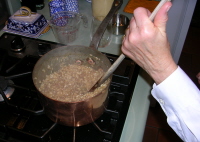| CLASSIC pasta | risotto -- how to make it | |||
|
|
This is the master plan for making risotto. The variations and the additions of different ingredients are almost innumerable. Ingredients:
The cooking technique, in a short form: Bring the stock to a slow simmer in a pan next to the risotto pan. In a thick-bottomed pan (the risotto pan), over medium-high heat, put in the olive oil. Add the onion. Cook until soft. Add the rice and stir until each grain is coated with the oil. Add the white wine. Cook and stir until it is absorbed by the rice, about two minutes. Keep the heat high. Add one quarter teaspoon salt and freshly ground pepper. Now add the hot stock, ladle by ladle, only adding another ladle when the previous ladle of liquid has been absorbed, stirring almost all of the time. The heat should be high enough so that there is always a gentle bubbling around the edges. Continue adding the ladles of stock until the rice is properly done: about twenty-five minutes or so. Determine proper doneness by tasting regularly. Take off the heat. Stir in the parmesan, and a tablespoon of butter. Serve in warmed dishes. The cooking technique, in more detail: Bring the stock to a simmer, and check it for seasoning. For a truly magnificent risotto, take your time and create a great stock, letting it simmer for several hours. Keep the stock very gently simmering, and put the stock pot close to the bigger pot that you be using for the risotto. Put the olive oil in the risotto pan, over a medium heat, and add the onion. Cook the onion slowly, stirring regularly with a wooden spoon. Cook the chopped onion until it becomes translucent; don't let it brown.
Add all the rice at once. Up the heat so the pan is hot enough so that the rice sizzles. Stir immediately and thoroughly. All of the rice kernels should be coated with the oil, one to two minutes.
Pour in the wine and let it boil, to release the alcohol. Anything from two to five minutes to get rid of the liquid. Make sure the pan remains hot. Add one-quarter teaspoon of salt and five twists of the pepper mill. Now add one-half cup of the simmering broth (or a ladle-full). Bring to a boil and then lower the heat to give it a steady simmer. You should maintain a vibrant bubbling of the stock around the edge of the pan. Stir all the time -- do not stop for long. Be sure to stir the bottom and the sides of the pan thoroughly as you go, so none of the rice is sticking. We use a wonderful wooden paddle kind of thing, which digs out the corners better than a wooden spoon.
As soon as all of this liquid has been absorbed by the rice, and you in effect can see the bottom of the pan (but not bone dry), immediately add another half cup of the simmering stock. Repeat the process, stirring constantly, and simmering, keeping that bubbling at the edge, until that batch of liquid is absorbed. Repeat the process again, with another half cup of simmering stock.
After about fifteen to eighteen minutes, from the time you added the wine, start checking the rice kernels for doneness. The risotto is done when the kernel is somewhat tender, not hard, but still has a firmness: al dente. You can tell that the risotto is getting towards done as the rice kernels get plumper, and seem to have more heart. As you are tasting, getting nearer completing the risotto, probably add a little less than a half-cup of liquid at each turn, making sure you get the proper doneness without having to overcook. (To guard against needing just a little more hot stock to add to the risotto to finish it, and finding we have run out of our prepared supply, we keep a tea kettle with boiled water near by to use for just such an emergency). The risotto should now be al dente, but creamy in overall texture. At this point it is possible to adjust your final result a little. If you want a creamier risotto, stir in a small amount more of stock at his point, but stop cooking. If you want a denser risotto, make sure that the last addition of stock has been almost totally absorbed.
Finish: take off the heat and fold in the parmesan and the tablespoon of butter. Taste for salt and pepper. We then cover the pan and let is sit for a minute or two. (We have adjusted our feel for al dente to allow this extra minute of sitting, covered, off heat). Serve on your warmed dishes. white wine or red wine: I have been told by native Milanese that intense arguments can develop between families on whether to use red wine or white wine in the risotto. Try them both. The classic Milanese should use the white wine, we think. For the sausage or other meat risottos, try red wine and see if you like it better. home-made stock: we are great believers that stock makes the risotto that extra special perfect. Excellent canned chicken or meat broth is fine. But home-made is better.
|
|||


